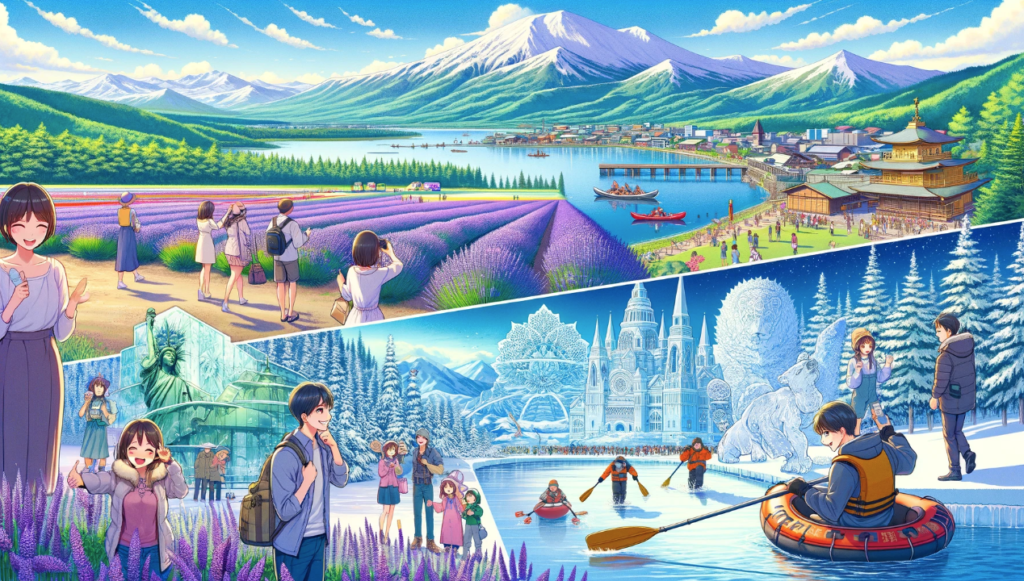
Lesson 57 Hokkaido
Topic Question: What are the unique features of Hokkaido’s landscape and climate that attract tourists?
No. 1: Introduction-First, try answering the question yourself.
The instructor will provide advice on vocabulary, grammar, and expression corrections.
Sample Answer – Let’s read aloud. The instructor will check your pronunciation and accent.
Hokkaido, the northernmost island of Japan, is renowned for its distinct landscape and climate, which differ significantly from the rest of the country. Its unique features include vast wilderness areas, active volcanoes, natural hot springs (onsen), and a cooler climate that supports diverse wildlife and vegetation. The island’s climate, with cold winters and mild summers, makes it a popular destination for both winter sports enthusiasts and summer vacationers seeking respite from Japan’s typically hot and humid summers. Hokkaido’s landscape is a mosaic of mountain ranges, crystal-clear lakes, and extensive national parks, offering breathtaking views and a host of outdoor activities throughout the year.
No. 2: Vocabulary Building – 5 Words to Learn and Their Meanings
Pronounce the Words Correctly (Pronunciation Training) + Make Sentences Using the Words Instantly
- Wilderness (原野, gen’ya): A wild and uninhabited area left in its natural condition.
“Hokkaido’s wilderness areas are home to spectacular natural beauty, drawing adventurers and nature lovers alike.”
- Volcano (火山, kazan): A mountain or hill, typically conical, having a crater or vent through which lava, rock fragments, hot vapor, and gas are being or have been erupted from the earth’s crust.
“The active volcanoes of Hokkaido, such as Mount Usu and Showa Shinzan, are fascinating natural attractions that offer unique landscapes and hot spring resorts.”
- Hot Springs (温泉, onsen): A spring of naturally hot water, typically heated by subterranean volcanic activity.
“Hokkaido’s numerous hot springs, surrounded by serene nature, provide the perfect relaxation spot after a day of skiing or hiking.”
- Wildlife (野生動物, yasei doubutsu): Wild animals collectively; the native fauna (and sometimes flora) of a region.
“The diverse wildlife of Hokkaido, including the famous brown bears and red-crowned cranes, adds to the island’s allure for nature enthusiasts.”
- National Park (国立公園, kokuritsu kōen): A scenic or historically important area of countryside protected by the federal government for the enjoyment of the general public or the preservation of wildlife.
“Shiretoko National Park, a UNESCO World Heritage site in Hokkaido, offers stunning landscapes, abundant wildlife, and outdoor activities like hiking and ice-walking.”
No. 3: Key Idiom and Example Sentences
“A breath of fresh air” (新鮮な息吹) – Something that is refreshing or invigorating.
“Hokkaido’s pristine natural environment provides a breath of fresh air for those escaping the bustling city life.”
“Visiting Hokkaido’s unique landscape and experiencing its cool climate is like a breath of fresh air for tourists looking for an extraordinary adventure.”
No. 4: Discussion and Exchange of Opinions on the Sample Answer
Instructor: How do you think Hokkaido’s distinct landscape and climate contribute to its appeal as a tourist destination?
Student: [Opinions of students]
No. 5: Free Discussion on the Topic
Let’s explore further the attractions of Hokkaido. Consider its unique festivals, such as the Sapporo Snow Festival, and local cuisine, influenced by its climate and geography. How do these cultural elements enhance the experience of visiting Hokkaido? Additionally, discuss the impact of tourism on Hokkaido’s natural environment and how sustainable practices can be promoted to ensure the preservation of its beauty for future generations.







